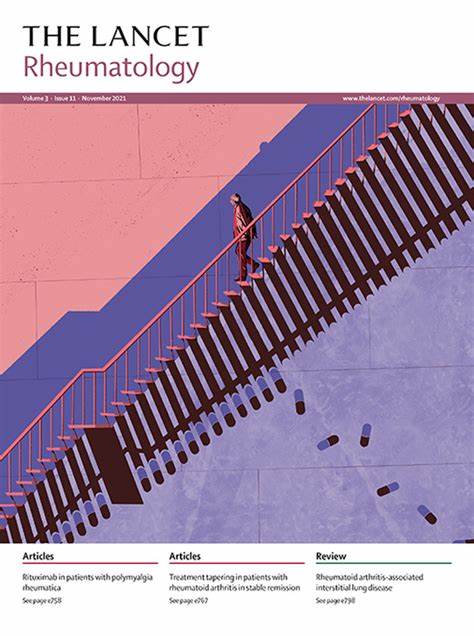Exposure to hydroxychloroquine in early pregnancy and incidence of pre-eclampsia and pre-term delivery in patients with systemic lupus erythematosus in Sweden: a nationwide population-based cohort study
IF 16.4
1区 医学
Q1 RHEUMATOLOGY
引用次数: 0
Abstract
Background
Pregnant women with systemic lupus erythematosus (SLE) have elevated risks of pre-eclampsia and pre-term delivery. Hydroxychloroquine, the mainstay treatment during pregnancy in women with SLE, is currently a promising agent for pre-eclampsia prevention. We aimed to examine associations between hydroxychloroquine use and pre-eclampsia and pre-term delivery in pregnant women with SLE.
Methods
In this nationwide population-based cohort study, we included all singleton pregnancies of women with prevalent SLE that lead to a delivery (livebirths and stillbirths) between Jan 1, 2007, and Dec 31, 2022, diagnosed in secondary or tertiary care centres in Sweden. Hydroxychloroquine exposure was defined as two or more dispensations from 3 months pre-pregnancy until the end of the first trimester. The primary outcomes were pre-eclampsia (diagnosed from 20+0 weeks of gestation to 6 weeks postpartum) and pre-term delivery (delivery before 37+0 weeks of gestation). Inverse probability of treatment weighting adjusted for measured confounders (eg, maternal smoking, BMI, reproductive characteristics, pre-gestational hypertension, glucocorticoid use) and modified Poisson models estimated risk ratios and 95% confidence intervals. We involved a person with lived experience of pregnancy with SLE in all aspects of the study.
Findings
Between Jan 1, 2007, and Dec 31, 2022, we included 959 singleton pregnancies from 685 women with prevalent SLE in Sweden. 404 (42%) of 959 pregnancies were nulliparous pregnancies (232 [57%] were unexposed and 172 [43%] were hydroxychloroquine-exposed) and 555 (58%) were parous pregnancies (333 [60%] were unexposed and 222 [40%] were hydroxychloroquine-exposed). The mean maternal age was 32 years (SD 4·7). Pre-eclampsia was recorded in 19 (11%) of 172 hydroxychloroquine-exposed pregnancies and 30 (13%) of 232 unexposed pregnancies in the nulliparous group and 12 (5%) of 222 hydroxychloroquine-exposed pregnancies and 20 (6%) of 333 unexposed pregnancies in the parous group. Pre-term delivery was recorded in 33 (19%) of 172 hydroxychloroquine-exposed pregnancies and 34 (15%) of 232 in unexposed pregnancies in the nulliparous group and 26 (12%) of 222 hydroxychloroquine-exposed pregnancies and 41 (12%) of 333 unexposed pregnancies in the parous group. The adjusted risk ratio for pre-eclampsia in SLE pregnancies with hydroxychloroquine exposure versus those without exposure was 0·49 (95% CI 0·31–0·79) overall, 0·59 (0·33–1·08) in the nulliparous group, and 0·44 (0·22–0·89) in the parous group. Associations between hydroxychloroquine and pre-term delivery were unclear in the overall (risk ratio 0·95 [95% CI 0·67–1·34]), nulliparous (1·10 [0·68–1·80]), and parous (0·75 [0·47–1·24]) groups. Stratification by antiphospholipid syndrome, renal diseases, and hypertension showed similar results.
Interpretation
In this large cohort of pregnant women with SLE, hydroxychloroquine exposure in early pregnancy was associated with a lower pre-eclampsia risk. However, the association with pre-term delivery was unclear.
Funding
US National Institutes of Health and the Ingegerd Johansson Donation.
瑞典系统性红斑狼疮患者妊娠早期暴露于羟氯喹与先兆子痫和早产发生率:一项全国性人群队列研究
背景:患有系统性红斑狼疮(SLE)的孕妇发生先兆子痫和早产的风险增高。羟氯喹是SLE患者妊娠期的主要治疗药物,目前是一种很有前景的预防先兆子痫的药物。我们的目的是研究羟氯喹的使用与SLE孕妇先兆子痫和早产之间的关系。方法:在这项以全国人口为基础的队列研究中,我们纳入了2007年1月1日至2022年12月31日期间在瑞典二级或三级保健中心诊断的所有患有SLE并导致分娩(活产和死产)的单胎妊娠妇女。羟氯喹暴露定义为从妊娠前3个月至妊娠早期结束期间两次或两次以上的剂量。主要结局为先兆子痫(诊断时间为妊娠20+0周至产后6周)和早产(妊娠37+0周前分娩)。根据测量的混杂因素(如母亲吸烟、体重指数、生殖特征、孕前高血压、糖皮质激素使用)和修改的泊松模型调整治疗权重的逆概率估计风险比和95%置信区间。我们在研究的各个方面都纳入了一位有SLE妊娠经历的人。结果:在2007年1月1日至2022年12月31日期间,我们纳入了瑞典685例SLE患者的959例单胎妊娠,其中404例(42%)为未产妊娠(232例[57%]未暴露,172例[43%]暴露),555例(58%)为已产妊娠(333例[60%]未暴露,222例[40%]暴露)。产妇平均年龄32岁(SD 4.7)。未分娩组172例羟氯喹暴露妊娠中有19例(11%)和232例未暴露妊娠中有30例(13%)发生先兆子痫;未分娩组222例羟氯喹暴露妊娠中有12例(5%)和333例未暴露妊娠中有20例(6%)发生先兆子痫。172例羟基氯喹暴露妊娠中有33例(19%)早产,未分娩组中232例未暴露妊娠中有34例(15%)早产,未分娩组222例羟基氯喹暴露妊娠中有26例(12%)早产,未分娩组333例未暴露妊娠中有41例(12%)早产。暴露于羟氯喹的SLE妊娠与未暴露于羟氯喹的SLE妊娠发生先兆子痫的调整风险比总体为0.49 (95% CI 0.31 - 0.79),未分娩组为0.59(0.33 - 0.08),已分娩组为0.44(0.22 - 0.89)。羟氯喹与早产之间的关系在总风险比(0.95 [95% CI 0.67 - 1.34])、未产组(1.10[0.68 - 1.80])和产组(0.75[0.47 - 1.24])中尚不清楚。抗磷脂综合征、肾脏疾病和高血压分层显示相似的结果。解释:在这个大型SLE孕妇队列中,妊娠早期暴露于羟氯喹与较低的先兆子痫风险相关。然而,与早产的关系尚不清楚。资助:美国国立卫生研究院和Ingegerd Johansson捐赠。
本文章由计算机程序翻译,如有差异,请以英文原文为准。
求助全文
约1分钟内获得全文
求助全文
来源期刊

Lancet Rheumatology
RHEUMATOLOGY-
CiteScore
34.70
自引率
3.10%
发文量
279
期刊介绍:
The Lancet Rheumatology, an independent journal, is dedicated to publishing content relevant to rheumatology specialists worldwide. It focuses on studies that advance clinical practice, challenge existing norms, and advocate for changes in health policy. The journal covers clinical research, particularly clinical trials, expert reviews, and thought-provoking commentary on the diagnosis, classification, management, and prevention of rheumatic diseases, including arthritis, musculoskeletal disorders, connective tissue diseases, and immune system disorders. Additionally, it publishes high-quality translational studies supported by robust clinical data, prioritizing those that identify potential new therapeutic targets, advance precision medicine efforts, or directly contribute to future clinical trials.
With its strong clinical orientation, The Lancet Rheumatology serves as an independent voice for the rheumatology community, advocating strongly for the enhancement of patients' lives affected by rheumatic diseases worldwide.
 求助内容:
求助内容: 应助结果提醒方式:
应助结果提醒方式:


